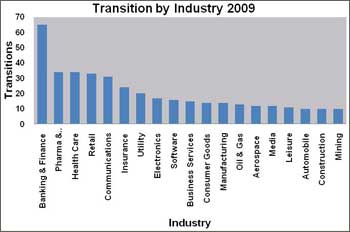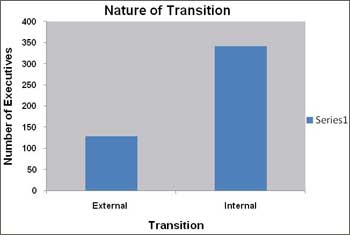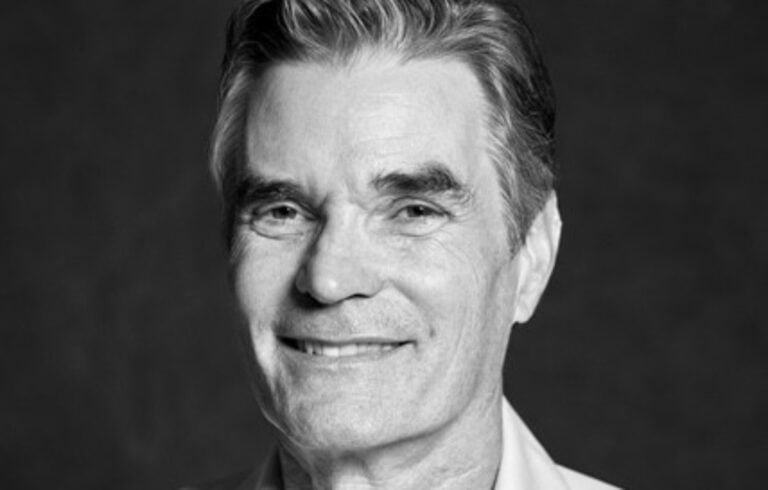
In its annual analysis of CEO transitions of publicly traded companies, Chief Executive Online has compiled 520 C-level executive changes during 2009. The compilation analysis also revealed that majority of corporate boards focused on succession planning, with many of them – about 65 percent – opting to promote internal candidates as CEOs, chairmen and COOs.
Transition by Industry
Banking and pharmaceutical sectors took the lead with as many as 65 and 34 transitions at the top respectively, mostly due to economic conditions in U.S.
According to a study by Standard & Poor the banking industry has reported losses worth $327 billion in 2008 and 2009 forcing S & P to maintain its negative outlook for the U.S. banking industry based on the Federal Deposit Insurance Corp.’s recently released industry financial performance data for fourth-quarter 2009.
While the banking industry currently faces the toughest challenges in 2010 in order to restore confidence and growth, the government’s regulatory role has affected the compensation of C- suite executives and resulted in reorganization of the top management at companies such as Bank of America, AIG and Hartford Financial to mention a few.
On the other hand, pharmaceutical industry CEOs focus’ on increasing revenues, continuing merger activities and changes in the operating models has also contributed to major reshuffling of top management.
Last year, healthcare represented 12 percent of the total transitions compiled by Chief Executive Online. Other sectors such as business services, software; manufacturing recorded an average of three percent respectively for the year 2009.

Nature of Transition
With corporate strategy focused on succession planning, most of U.S. corporations chose to promote internal candidates as CEOs, chairmen and COOs.
While 65 percent of the successors to various positions have been identified internally, only 35 percent of the candidates were external replacements. Banking and finance sector recorded the highest number of internal replacements with as many as 42 candidates chosen as successors from within the company, while the pharmaceutical sector had the largest number of external hires, with 25 executives recruited from outside and only five from within.
Additionally, many boards chose to elevate COOs – as many as 47 of the total 75 outgoing COOs were promoted as CEOs. While 12 CEOs became chairmen, about 34 board members were named CEOs.

Executive Role
Executive turnover figures reveal that out of the total 520 transitions compiled by CE Online, CEOs make up for the majority share with 277 CEOs stepping out of their responsibilities in various top management reshuffles. Out of the total tally, while 66 percent of CEOs stepped down voluntarily, the remaining were asked to take up new roles.
Interestingly, not many CEOs have been asked to quit or step down. Only three CEOs were ousted accounting for a mere 1.08 percent of the total CEO transitions for 2009.
While company president’s accounted for the least number of transitions with two percent of the total transitions reported, COOs accounted for 15 percent. Additionally 25 percent of the 51 retiring chairmen continued as board members, 35 percent of the executive chairmen opted to relinquish their roles as CEOs.

Tenure in Office
Of all the C–suite transitions recorded, chairmen of boards had the longest stint with an average tenure of 10 years in office. While CEOs served for an average of eight years, COOs and Presidents had the shortest stint with four and five years respectively.
Interestingly, the banking sector which recorded the highest CEO turnover, boasted of longest CEO tenure with the banking CEOs averaging about 9.73 years in office, while their counterparts in all the other sectors put together had the average tenure of 7.10 years.

Research & Graphics by Aparna Reddy
Note **



0

1:00 - 5:00 pm
Over 70% of Executives Surveyed Agree: Many Strategic Planning Efforts Lack Systematic Approach Tips for Enhancing Your Strategic Planning Process
Executives expressed frustration with their current strategic planning process. Issues include:
Steve Rutan and Denise Harrison have put together an afternoon workshop that will provide the tools you need to address these concerns. They have worked with hundreds of executives to develop a systematic approach that will enable your team to make better decisions during strategic planning. Steve and Denise will walk you through exercises for prioritizing your lists and steps that will reset and reinvigorate your process. This will be a hands-on workshop that will enable you to think about your business as you use the tools that are being presented. If you are ready for a Strategic Planning tune-up, select this workshop in your registration form. The additional fee of $695 will be added to your total.

2:00 - 5:00 pm
Female leaders face the same issues all leaders do, but they often face additional challenges too. In this peer session, we will facilitate a discussion of best practices and how to overcome common barriers to help women leaders be more effective within and outside their organizations.
Limited space available.

10:30 - 5:00 pm
General’s Retreat at Hermitage Golf Course
Sponsored by UBS
General’s Retreat, built in 1986 with architect Gary Roger Baird, has been voted the “Best Golf Course in Nashville” and is a “must play” when visiting the Nashville, Tennessee area. With the beautiful setting along the Cumberland River, golfers of all capabilities will thoroughly enjoy the golf, scenery and hospitality.
The golf outing fee includes transportation to and from the hotel, greens/cart fees, use of practice facilities, and boxed lunch. The bus will leave the hotel at 10:30 am for a noon shotgun start and return to the hotel after the cocktail reception following the completion of the round.